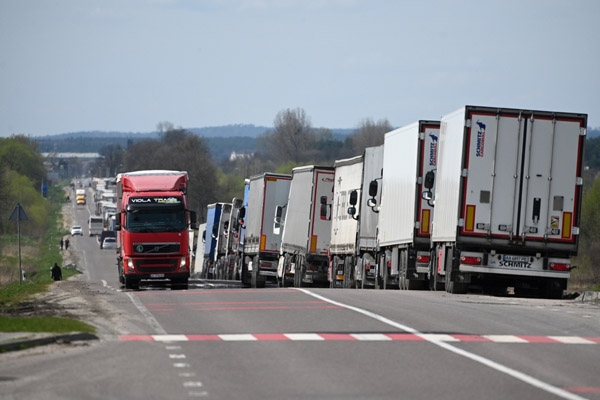The growing intensity and interconnectivity of disruptive events means building always-on resilience is an imperative for transport organisations. So why are so many waiting for fresh disruption before they act?
In recent years, major disruptive events have tested the resilience of transport organisations as never before.

Sara Ulrich
Economic uncertainty, political instability, war in Ukraine, the sustainability imperative, and the lingering effects of the worldwide COVID-19 pandemic have transformed the landscape across road, rail, aviation, and logistics. In some cases, disruption has threatened organisations’ very survival.
Resilience rewritten
As a result, organisations have been forced to assess and improve their resilience. In our recent survey of 360 transport leaders across Europe, almost nine in ten told us resilience is a strategic imperative.
As well as resilience climbing the board agenda, there’s evidence that transport leaders are reappraising what ‘resilience’ means to them and their organisations. They understand that conventional resilience plans, reached for and ‘switched on’ in the event of disruption, are no longer enough. Instead, almost eight in 10 leaders agreed that ‘resilience means looking at everything we do, constantly tweaking as our organisation changes’.

Ukraine April 2023
We agree. Resilience now needs to be far broader than a set of operational plans for ensuring business continuity in the event of a major disruption. It needs to be concerned with ensuring strategic continuity through the gathering storm of constant, concurrent, disruptive events.
This means resilience needs to be a capability that’s always-on – a permanent capability that extends across every part of the organisation, and beyond to how transport organisations engage with partners and suppliers across modes and countries. Here, always-on resilience means being ready for what comes next rather than always responding. And this frees up the organisational headroom to move ahead of customer trends, experiment with new technology, and re-shape delivery models.
Are transport organisations walking the talk?
We supplemented our survey with a score of in-depth conversations with transport leaders. What they say about resilience is positive – with many now citing it as a top-level priority. But a closer look is less reassuring. While leaders talk about making resilience a strategic imperative, their actions sometimes fail to match their ambitions.
For example, as the pandemic fades from immediate memory, over half of the leaders we surveyed say the worst has already happened. Meanwhile, only half say they are adopting a strategic approach to building resilience, with the remainder depending on ad-hoc development. And despite the threats from mounting disruptive events, 65 % have no plans to increase investment in resilience.
Hooked on disruption
The strongest evidence that urgency around resilience is waning lies in how leaders rank resilience accelerators. One in four say ‘more disruptive events that force us to prioritise resilience’ are the number one accelerator.
In effect, many organisations are waiting for fresh disruption to reignite a sense of urgency. They are hooked on the disruption-response cycle, where discussions around resilience only spring to life in response to an event.
Time to make resilience a sustained strategic priority
So, what needs to change? Rather than waiting for further disruption, transport organisations must act now to make resilience a sustained strategic priority. Leaders have a critical role to play in building this switched-on, fluid capability.
There are three steps to transforming resilience and building on the opportunity created by the current and future challenges of continued, concurrent disruption – often framed as either the ‘permacrisis’ or ‘polycrisis’.
1. Embed a resilience mindset
Elevating resilience depends on how people at every level in the organisation respond when disruption strikes – from the board right through to operational and customer-facing staff. Our recommendations focus on:
- seizing the strategic momentum to ensure your organisation has robust, deliverable ambitions
- adopting a model of leadership that empowers people to perform effectively during a disruptive event – freeing leaders to focus on leading
- planning for perma-disruption, because the evolving mix of threats and risks makes process and structure vital.
2. Train your resilience muscle
Always-on resilience demands superior flexibility across operations and processes. So it’s now more important than ever to overcome the organisational sluggishness that impedes flexibility and design new ways of operating that maximise resilience. Our recommendations focus on:
- prizing and developing adaptability by developing clear parameters for success, and providing the apparatus to deliver
- building muscle memory through wargaming exercises, so that the response to disruption is instinctive, anticipatory, and seamless
- committing to continuous improvement by being willing to learn from and share previous failings or mistakes, and making these a springboard for further transformation and innovation.
3. Develop a resilient ecosystem
The transport ecosystem, with its complex, cross-modal links, presents a unique resilience challenge. Disruption spreads easily across modes – and even across national boundaries. Our recommendations focus on:
- seeing suppliers as strategic resilience partners, including building resilience considerations into the procurement process
- increasing collaboration and knowledge share across modes, to ensure that customer outcomes come before competitive boundaries
- linking up across transport ecosystems, including engaging with cross-modal national and international initiatives.
Ready for action?
After years of unprecedented disruption, transport leaders might be tempted to believe things are returning to normal. Nothing could be further from the truth. New disruptive events and trends are challenging the sector to develop a completely new type of always-on resilience.
Ultimately, this comes down to organisational survival – the ability to adapt and evolve to meet new threats in a sector where disruption will be a constant presence for years to come. Yet it’s also about competitiveness and growth – moving from ad-hoc responsiveness to a sustained level of resilience that enables you to anticipate, adapt to, and even shape the future.
This is the challenge and opportunity of the moment for transport leaders – and our recommendations propose practical ways to kick-start action, as well as providing an opportunity for leaders to build and share their views on a much-needed transport resilience agenda for change.
Sara Ulrich is a resilience and wargaming expert at PA Consulting
Register now for full access
Register just once to get unrestricted, real-time coverage of the issues and challenges facing UK transport and highways engineers.
Full website content includes the latest news, exclusive commentary from leading industry figures and detailed topical analysis of the highways, transportation, environment and place-shaping sectors.
Use the link below to register your details for full, free access.
Already a registered? Login